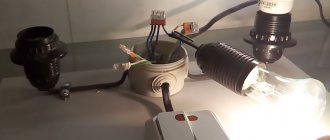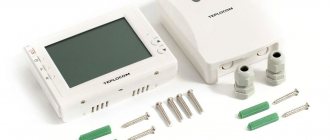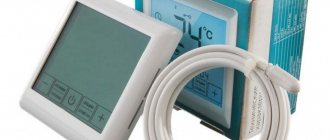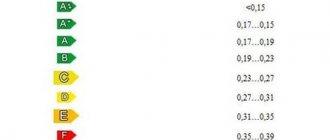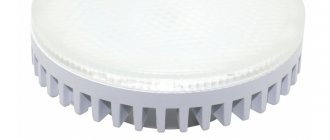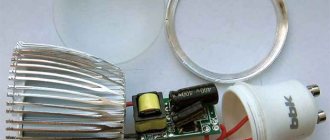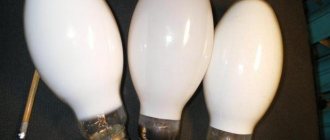LED light bulbs are gaining popularity and are replacing classic incandescent lamps due to their durability and efficiency. A large selection of shapes and sizes allows you to diversify your interior. The power of LED lamps differs from that of Ilyich bulbs. To choose a replacement, you need to clarify some data and compare it with the ratio table.
Lamps based on energy-saving LEDs are safe for human health . Their use is permitted in children's and medical institutions. However, lighting standards must be taken into account .
- Light flow . The average is 100 Lm/1 W. Bulbs produce from 250 to 2500 lm.
- Light temperature from 2700 to 6400 Kelvin (cold, daylight, warm light).
- Scattering angle from 60 to 340°.
- Light transmission index up to 100 Ra.
- Energy efficiency class A, A+, A++.
- Power consumption from 3 to 30 W.
- Rated voltage 220 Volts.
- Operating temperature range from -10 to +40°.
- Service life from 30 to 50 thousand hours.
Conventional lamps are produced with sockets . For luminaires designed for 12 Volts, types GU4, GU5.3, GU10 are used.
You can choose lamps of various shapes and sizes . Before purchasing, you should measure the diameter and height of the lampshade so that the light bulb will fit into it.
The cost of LED lamps pays off quite quickly due to reduced energy consumption and infrequent replacement.
How much is 7 watt LED - Comparative table of the ratio of luminous flux (lumens) to lamp power consumption (W) for LED lamps, incandescent lamps and fluorescent lamps. 20-200
These bulbs gave ideal results in terms of power and illumination ratio. The illumination was almost the same. And the LED light bulb consumed 10 times less energy than an incandescent lamp, and 2 times less than an energy-saving gas-discharge lamp.
Expert opinion
Viktor Pavlovich Strebizh, lighting and electrical expert
Any questions ask me, I will help!
And the LED light bulb consumed 10 times less energy than an incandescent lamp, and 2 times less than an energy-saving gas-discharge lamp. If there is something you don’t understand, write to me!
LED lamp power
When changing light bulbs, it is necessary to take into account the correspondence between the power of incandescent lamps and LED luminous flux . Characteristics are measured in the same quantities. To navigate the indicators and correctly translate the values, you can use the following table of ratios.
For example, a 60 W incandescent lamp corresponds to a 7 W LED lamp - so that the conversion is correct, they are guided by the data on the packaging. The presented values indicate one of the main advantages of LEDs - economic benefits.
What kind of lighting do you prefer?
Built-in Chandelier
Based on the results of laboratory tests, it turned out that the intensity of the luminous flux decreases over time. The power consumption of electrical energy remains at the same level, but the glow fades. With constant use, it is difficult to notice the difference. But if you replace a used lamp with a new one, the difference will be obvious.
Calculation of the power of LED lamps for the home
Before repairs, installation of electrical wiring and lamps, it is necessary to calculate the rated power indicators in order to avoid burnout of devices, short circuits and other problems. To determine the final data you need to know:
- level of natural light – A;
- area of the room (room, for example) – B;
- total number of lighting fixtures – C;
- luminous flux – D.
To calculate the luminous flux , I use the formula: D = A * B / C. The illumination level is calculated as follows: A = C * D / B.
For each square meter, it is necessary to determine the placement of lamps in the room in order to capture the entire space. Moreover, the efficiency of LEDs is maximum within an angle radius of 120° .
Total power in W: how much energy do household appliances consume in kW
Any apartment is equipped with the necessary set of household appliances and electrical equipment. Each type of equipment has individual technical characteristics, including power and energy consumption. The total value of all these factors determines the total amount of electrical energy consumed, which will be different for each family.
Distribution of energy consumption by electrical appliances as a percentage.
In order to plan possible expenses, some owners resort to compiling a table of electricity consumption by household appliances per hour, where they indicate the name of the consumer, its power and duration of operation throughout the day. Information about the total energy consumption of household appliances and lighting elements is necessary for installing switching and protective equipment and selecting the cross-section of electrical wiring.
On a note! To determine the total power, the corresponding consumer values must be converted into one unit of measurement, so it is important to know how many W are in 1 kW.
From the table below you can conclude which household appliances consume more electricity. These include a lighting system, refrigerator, TV, computer, washing machine, electric kettle and iron. The total value averages 120-180 kW per month. Additional costs include the use of small household appliances in the form of a hair dryer, coffee maker, food processor, chargers and other elements that provide the required level of comfort. In the summer, the use of air conditioning is also taken into account, and in winter - oil electric heaters, which add 60-100 kW.
Benefits from using LED lamps. Calculation
The review would be incomplete without a practical comparison of the two lamps over the long term. Take, for example, a 40 W incandescent light bulb. Let's further assume that a person uses it on average 6 hours a day, that is, in total over 365 days this will be about 87,600 Wh per year.
An equivalent LED lamp, depending on the manufacturer, consumes 4.5 W or 9855 W/hour per year. To sum it up simply, the conclusion suggests itself: an incandescent lamp consumes 8.88 times more energy.
Disadvantages of LED lamps
There are, of course, disadvantages to LED lighting that are worth mentioning. First of all, this is its price. At the moment, their cost is higher among analogues. But the low power requirement of LED lamps described above and the longer operating life more than compensate for the high prices.
The heating level of LED sources is much lower than that of incandescent lamps, but is still present and can have a negative impact on the lighting system. For this purpose, special heat-removing radiators are installed in the models, but the installation of models with high power requires additional cooling measures.
conclusions
In general, LED confidently holds the leadership palm in the lighting market. And although there is still an opinion that the light of an incandescent light bulb is more pleasing to the eye, even here the LED analogue can outperform its counterpart due to the large selection of glow colors - from warm to cold. But the choice, as always, is up to the buyer.
| Power, W | Luminous flux in Lumens | ||
| Incandescent | Luminescent | LED | |
| 20 | 5-7 | 2-3 | 200 |
| 40 | 10-13 | 4-5 | 400 |
| 60 | 15-16 | 8-10 | 700 |
| 75 | 18-20 | 10-12 | 900 |
| 100 | 25-30 | 12-15 | 1200 |
| 150 | 40-50 | 18-20 | 1800 |
| 200 | 60-80 | 25-30 | 2500 |
Expert opinion
Viktor Pavlovich Strebizh, lighting and electrical expert
Any questions ask me, I will help!
For the operation of luminescent energy-saving devices, a choke is required that provides the necessary electrical impulse, due to which an arc discharge is formed in the mercury vapor with which the bulb is filled. If there is something you don’t understand, write to me!
What is more profitable?
When determining the most economical option, consider the operating time of each type of llama and their cost. We immediately discard the usual ones because they burn out more often and consume more.
But energy-saving and LED ones need to be sorted out. Energy saving - price about 250 rubles, service life 10,000 hours (4.6 years) LED - price about 350 rubles, service life 30,000 hours (14 years with 6 hour use)
For 14 years we will pay for energy-saving ones - 576 * 14 = 8064 rubles + replace light bulbs 3 times. For 14 years for LED ones - 408 * 14 = 5712 rubles.
As we see, in the longer term, the most profitable option is LED
When calculating, we took average figures, but someone has large production areas with lighting in which only replacing light bulbs will help save decent amounts of money in their wallet.
Supply voltage for household devices using diodes
LED flashlights
LED lights vary significantly in brightness and power. Therefore, it is difficult to say exactly how many volts there are in an LED light bulb.
An ordinary household flashlight has a bright 3.3 V diode installed. Thanks to the use of special circuits that increase the voltage, they comfortably operate from one 1.2 V AA battery or a 1.8 V battery.
How many volts are the LEDs in high brightness flashlights? Signal lights for special purposes are equipped with special diode matrices with a supply voltage of 3.3V - 4.7V and a current of up to 2000mA.
Powerful 3.7V lithium batteries are used to power them.
LED strips
The supply voltage of the tape and its power depend on the type of LEDs used.
Expert opinion
Viktor Pavlovich Strebizh, lighting and electrical expert
Any questions ask me, I will help!
The latest generation lamps have a different approach; light is formed after the activation of various chemical compounds of the phosphor. If there is something you don’t understand, write to me!
conclusions
- Thus, if these trends continue, LEDs will displace compact fluorescent ones during 2016 - 2022. and will replace them (by 85%) by 2022.
- It is worth mentioning the versatility of LEDs, which can be used both for a pocket flashlight and for home and street lighting.
Useful tips Connection diagrams Principles of operation of devices Main concepts Meters from Energomer Precautions Incandescent lamps Video instructions for the master Testing with a multimeter
Lamp power ratio table
Often on product packaging, next to the power ratings, you can see equivalent values for other types of lamps. This allows you to select the appropriate LED to replace a conventional filament light bulb or fluorescent device.
| Lamp type | Power, W | |||||||||||
| Light-emitting diode | 6 | 7 | 8 | 9 | 10 | 11 | 12 | 13 | 15 | 16 | 18 | 20 |
| Incandescent lamp | 50 | 60 | 65 | 75 | 80 | 90 | 100 | 105 | 125 | 145 | 160 | 175 |
| Fluorescent Lamp | 30 | 35 | 40 | 45 | 50 | 55 | 60 | 65 | 75 | 80 | 90 | 100 |
Important! The design features of the device are also of considerable importance. So, if there is a matte coating on the bulb, the luminous flux can decrease by 8-10%.
How much does an LED consume?
Remember these numbers - 230, 415, 720, 940 and 1350 lumens . And be guided by them when you choose an LED lamp.
Expert opinion
Viktor Pavlovich Strebizh, lighting and electrical expert
Any questions ask me, I will help!
If you're used to having a 75-watt incandescent bulb in your kitchen, then you need an LED bulb that provides the same amount of light. If there is something you don’t understand, write to me!
Refrigerator: how many watts does it consume per hour?
When answering the question of which electrical appliances consume the most energy, the refrigerator will be first on the list. This device works around the clock. The actual energy consumption of the refrigerator is calculated taking into account the international classification of energy efficiency devices. This parameter is designated by a letter with a certain number of pluses; the more there are, the lower the level of electricity use.
The classification of a household appliance by energy efficiency is as follows:
- A++ - the highest class with maximum energy saving. Electricity consumption is 30% of the standard value;
- A+ - energy consumption - 30-42% of the standard;
- A - energy consumption - 42-55% of the standard;
- B - energy consumption - 55-75% of the standard;
- C – energy consumption – 75-90% of the standard;
- D – energy consumption – 90-100% of the standard;
- E - energy consumption - 100-110% of the standard;
- F - energy consumption - 110-125% of the standard.
However, the energy efficiency parameter is very average. Since the amount of electricity consumed by the refrigerator is affected by its operating mode, workload, and the number of door openings.
The refrigerator consumes the most energy of any electrical appliance.
On a note! The instructions for the refrigerator indicate the energy efficiency class and the amount of electricity it consumes per hour.
Annual energy consumption corresponds to 220-460 kW. It is impossible to obtain an accurate result for a table of electricity consumption per day or month by simply dividing this value. Since energy consumption is influenced by a number of factors, such as freezing power, ambient temperature, and product filling level.
To reduce the energy consumption of the refrigerator, it is necessary to operate the device correctly, do not leave the internal space empty when it is turned on, do not open the door for a long time, do not put hot food in, check the condition of the seals, ensure that there is a gap between the refrigerator and the wall, regularly defrost, wash and dry the unit.
What costs does a traditional lighting system require?
A traditional household lighting system includes 220V wiring, switches, lighting fixtures, and lamps. If the power of all lighting devices exceeds 3.5 kW, the system is divided into subsystems that are connected to a separate residual current device (relevant for large country houses).
When using incandescent lamps, the consumer can choose lighting fixtures at his own discretion. The final cost of the system depends on their price. Lamps are sold at different prices, depending on the design and manufacturer. The price of incandescent lamps also varies. For products from Russian manufacturers, the average value is 15 rubles.
Other manufacturers have different prices:
- Philips 60W – 30 rub., 40W – 35 rub., color 10W – 38;
- “candle” Foton 25W – 29 rubles;
- “pear” Osram 75W – 31 rubles, 40W – 32.
The final cost will depend not only on the area of the home and the power of the lighting fixtures, but also on the preferences and financial capabilities of the family. When purchasing expensive lamps and switches, dimmers, and imported light bulbs, the initial costs will increase not only during purchase, but also during the installation process. To include dimmers in the circuit, you will have to invite a specialist who knows exactly how to do this work.
Attention! Power consumption can be affected by illuminated switches and dimmers. The former consume a small amount of watts, the latter allow, if necessary, to reduce the intensity of the glow while simultaneously reducing the power
Flaws
In addition to all the advantages, it is worth considering some of the disadvantages of such lamps, namely:
- Reduced light brightness over long periods of use.
- The need for cooling.
Despite the fact that the operating time of an LED lamp can reach up to 30,000 hours, according to manufacturers, by the end of its life, the LED burns out and the light becomes less bright. In domestic conditions, when lighting does not need to be used around the clock, this is not so critical.
Also, an LED lamp will be impractical to use in closed lampshades. Under such conditions, it heats up more and can fail faster.
Possible nuances
If you consider that the lifespan of an energy-saving lamp can reach 20,000 hours, then it helps save money very well, even if you subtract its payback. However, it is worth remembering that such lighting devices are very “sensitive” to the negative influence of the external environment.
The following factors can cause premature failure of a lighting device:
- high voltage surges in the network (only if the manufacturers use a low-quality fuse);
- high humidity, which leads to breakdown of the condenser;
- too low and too high air temperature (affects the quality of light output and lamp heating time);
- Frequent switching on and off of the device (the interval between switching on and off must be at least 10 minutes).
Consumers can take advantage of the warranty if available. However, to replace a lighting fixture with a new one, the seller may require confirmation that there have been no sudden voltage drops in your network during its entire service life. Few people want to go to the energy company to get the document; it’s easier to buy a new light bulb.
